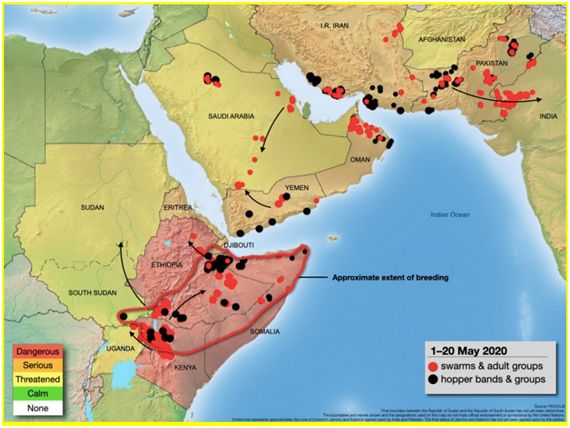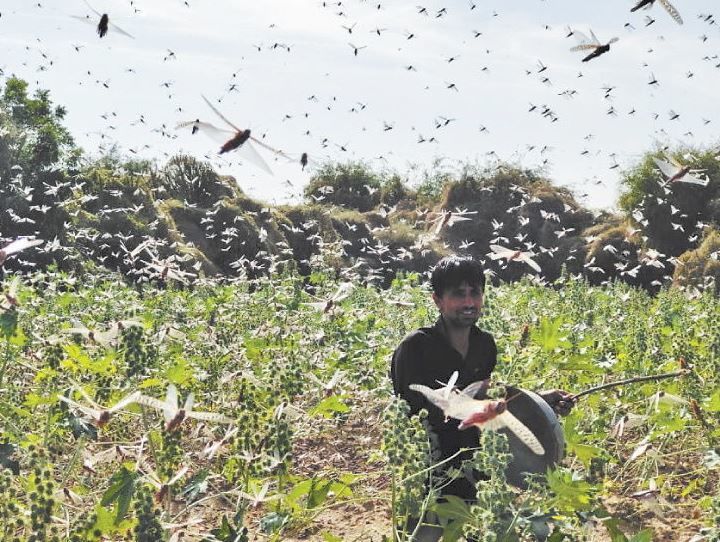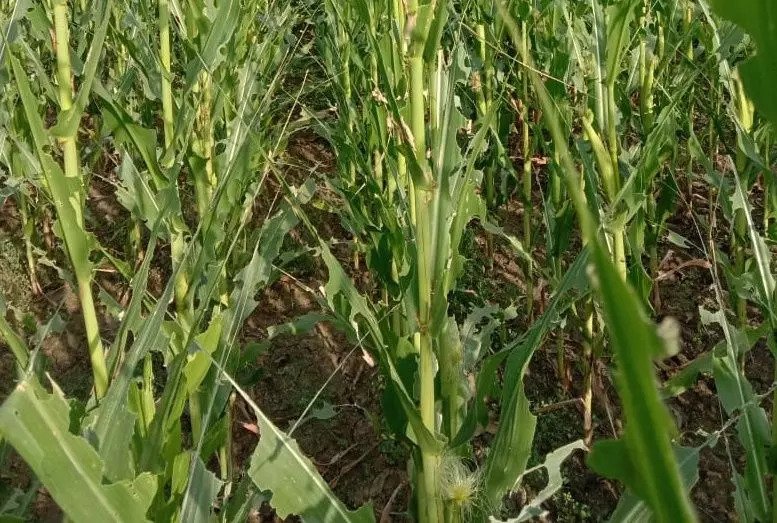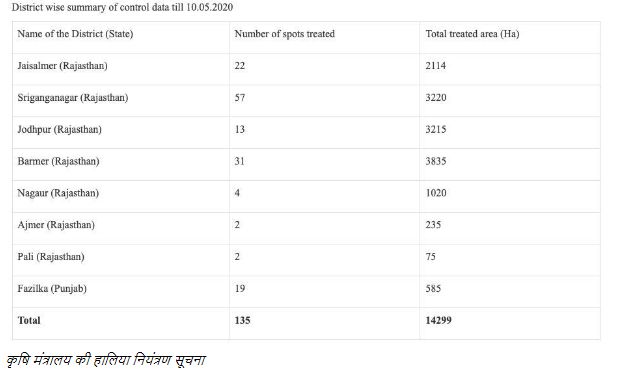“The locust outbreak in India may have its root in climate change”
Although desert locust attacks are common in Western Rajasthan and Gujarat during summers, for the first time, the Locust Warning Organisation has spotted them in April this year. Desert locusts are usually found in small groups, which means that the present swarm behaviour is abnormal

Photo: Twitter
The country is presently dealing with the coronavirus pandemic and the resultant lockdown. Meanwhile, a swarm of locusts has stormed into our country. These locusts usually wreak havoc in Rajasthan and Gujarat, but for the first time in the past two-and-a-half decades, these locusts have entered Maharashtra, Uttar Pradesh, and Madhya Pradesh.
The worst locust outbreak seen in the last twenty-five years is a major threat to food security. Locust swarms are currently destroying crops in the Western parts of India and are likely to hit the Eastern parts too. Post their spring-breeding in Southern Iran and South-Western Pakistan, a persistent attack of locusts is feared from now until the beginning of July. As per the Food and Agriculture Organisation of the United Nations (FAO), these locust attacks are going to intensify with rains. The United Nations has warned that this year, India’s farmers are at a “serious risk” from locusts swarms. As per the Environment Ministry, Rajasthan remains the worst-affected state in the country.
Although desert locust attacks are common in Western Rajasthan and Gujarat during summers (almost June to November), for the first time, the Locust Warning Organisation has spotted them in April this year. Since locusts are usually found either solitary or in small groups, it means that the present swarm behaviour is abnormal.

How is this going to affect India?
● As soon as the sowing season begins, the Kharif crop, rice, maize, bajra, pulses, and soybean become vulnerable to locust attack
● Damage to the agricultural economy and the livelihood of agricultural workers
● A potential risk to food supply if the outbreak is not diffused

Is it related to climate change?
Climate change has made the weather conditions more conducive to the current outbreak (still underway in East Africa, see below). The extreme and unusual weather conditions, including a powerful cyclone season last year, have creating wet conditions that have given a boost to the current outbreak. The same thing applies to India too.
Locusts thrive in wet conditions, and often these outbreaks occur after floods and cyclones. According to the World Meteorological Organization (WMO), heavy rains lead to the development of vegetation in arid areas, providing the necessary conditions for the development and breeding of locusts.
The 2019 Northern Indian Ocean cyclone season has been the most active that have been recorded so far. India has had an abnormal monsoon season, which was a month longer than normal, bringing widespread floods and the highest level of monsoon rainfall in the past twenty-five years. It also includes an unusual number of low-pressure systems (meaning more rain) associated with the ocean circulation patterns called the Indian Ocean Dipole (IOD) that measure the difference in water temperature between the opposite sides of the Indian Ocean. The Indian Ocean Dipole (IOD) is a primary driver of the climatic conditions from Africa to Australia.

The positive phase of IOD in the year 2019 was the strongest in six decades. These conditions had caused severe rainfall and flooding in East Africa as well as unusually dry conditions in Australia leading to bush fire (forest fires) besides extended monsoons in India.
The positive phases of the IOD are becoming more common, and scientists believe climate change is responsible for this. Academic studies have found that the strongly-positive phases of the IOD have evolved more in recent decades and that climate change is behind this growth.
As greenhouse gases continue to warm up the ocean and the atmosphere, extreme events caused by the IOD are predicted to be increasingly commonplace. According to a 2014 study, unusually positive IOD events could be nearly three times higher this century if emissions continue to rise. A separate study found that it is twice as likely to happen with the mere rise in temperature by 1.5 degrees celsius – we are already witnessing it slightly higher than that.
The older extremely positive IOD years will probably bring floods and cyclones, such as already been seen in the unsafe and food-insecure areas of 2019. Wet conditions can cause further worse locust outbreaks – worst-case scenario, they can destroy the livelihoods of one-tenth of the world’s population, according to the FAO (P2).

The spread of the outbreak from East Africa
Originating in East Africa, the locust attack is the worst that Eritrea, Ethiopia, and Somalia have experienced over the past 25 years, over 60 years in Uganda, and over 70 years in Kenya. The outbreak occurred at a gap of one year from the extreme drought and floods in these areas. As a result, the United Nations appealed for $138 million to deal with the escalating crisis. The World Bank had recently approved $500 million in grants and low-interest loans to deal with the issue. The African Development Bank has also approved an emergency grant of $1.5 million.
The current outbreak in East Africa has been described as ‘extremely dangerous’ by the Food and Agriculture Organisation (FAO) of the United Nations, and it puts food security and livelihoods at risk. According to the FAO, the second generation has already been hatching and the third generation will be ready by the harvesting season towards the end of July. This could pose a serious threat to the food security and livelihood to the rural population of the region and may even lead to a famine depending on the magnitude of the production deficit.
The outbreak is an unprecedented threat to food security, according to the FAO, which arises in an area that is already vulnerable to the effects of climate change. Even before the outbreak, at least 33 million people in the Eastern and Southern Africa were at the emergency levels of food insecurity due to floods, landslides, droughts and cyclones, according to an analysis by Save the Children.
The outbreak of locust is likely to spread to South Sudan, Uganda, Oman, Pakistan, India, Saudi Arabia and Southern Iran, among other countries and would threaten livelihoods while spreading. In the coming months, the attacks are likely to worsen as locusts will be feasting upon new season crops.
Along with COVID-19, the outbreak would deteriorate the acute food insecurity faced by the already complex and vulnerable region. In Somalia, in the April-June period, the number of acutely food-insecure people due to the drought and conflict was estimated to increase by 13% to 1.3 million people, while 1.5 million people will face severe food crisis in Uganda for the same reason. Somalia has already declared a national emergency due to the dispersion in February 2020, while Pakistan had declared a national emergency for the second time in April this year.

What are locusts and how to control them?
Life cycle: Locusts are a part of the same species of insects, but their behavior and form develop further in crowded conditions — this is called a phase change. These crowded conditions are caused by a lot of rain and vegetative development and allow the construction of a swarm of wingless locust. If the population increases uncontrolled, the locusts move to the raging or swarming phase.
When the phase change occurs (described as a change in the living state from solitude to furious/raging state of a swarm), locusts no longer act as one insect, but as a swarm. Since giant locusts make their environment more adaptable than their solitary type, they dominate very large areas and therefore cause concern. If locust swarms prevail in two or more areas, a plague develops, as has happened in East Africa and India. Although desert locusts (currently present in India) exist in their solitary form in 30 countries (16 million square kilometers), they swell across more than 60 (29 million square kilometres) during disasters.
Prediction and control: Desert locust biology is dependent on weather, especially rainfall, temperature and wind.
Precipitation: Eggs, hoppers and adult stages of development have all been supported by the recent rains. The year 2019-20 has been extremely wet for both East Africa and India.
Temperature: Temperature requirements vary depending on the state of development. Locust swarm will fly at 15°C when there is sunshine, but it needs to be warmer under cloudy conditions (about 23°C) for it to be airborne.
Wind: Desert locusts are passive flying species, that is, they usually follow the wind current. Predictions by the NOA wind pattern are being used by the FAO to try to predict their spread, although these are not associated with the locust lifecycle. In Rajasthan, the wind prevailing from April to October is from the West. However, when the wind exceeds 6-7 m/s, locust swarms are unlikely to fly.
These elements predict the movement and development of locusts/locusts and research continues to improve the forecasts further.
Locust control is usually carried out by spraying of chemical insecticide but other suggestions include biological mechanisms such as the introduction of natural insecticides from natural predators.
In India, locust survey and control are the responsibility of the Locust Warning Organisation (LWO) under the Ministry of Agriculture. India and Pakistan cooperate on the border to share information. Control operations for locusts are limited due to the paucity of resources and the ongoing pandemic, but the response continues. Tractor-mounted sprayers and fire vehicles are being used to spray areas (see below). The government is also considering the use of drones for observation and spraying, along with restrictions around airports and international borders.

What are the experts saying?
As per Ajayveer Jakhar, the president of the Bharatiya Kisan Manch, “The government will have to go beyond giving alerts and advice on the management of the locust outbreak, and immediately arrange for aerial sprays of pesticides to control the rapidly-growing situation. The states do not have the means to manage the scale of the outbreak this year.”
Devinder Sharma, an agriculture and trade policy expert, “The situation is advancing very rapidly and is extremely grave. Locust swarms have now reached five states — Rajasthan, Gujarat, Madhya Pradesh, Uttar Pradesh and Maharashtra. Locusts cause worse destruction than drought, not only by destroying crops, but also trees. Due to the unseasonal rains and the increased cyclonic activities this year, locusts are breeding 400 times more than normal finding favourable climatic conditions. The government’s preparedness for this rapid growth has been very slow. They have to step up their support. This is an emergency situation that requires emergency measures. These locusts will not only leave a serious impact on India’s food production, but also the farmers who are already reeling under the economic crisis due to COVID 19 and the lockdown.
(The writer is an independent journalist and an advisor to Global Strategic Communications Council)

